Building Communication Strategy: the Ultimate Guide
- Home / Marketing & Partnerships / Bouwen Communicatiestrategie: de ultieme gids

Communicatie-strategie bouwen: de ultieme gids
Communicatie is wat mensen bij elkaar houdt - en hetzelfde geldt voor mensen en merken. Communicatie is voor altijd en altijd een essentieel onderdeel van het product. Als klanten houden van de manier waarop je met hen communiceert en het zorgt ervoor dat ze zich geliefd en verzorgd voelen, zal dit waarschijnlijk resulteren in meer omzet en meer inkomsten voor jou.
We leven in het digitale tijdperk, waar de informatiestromen eindeloos zijn en het gemakkelijk is voor merken om in het lawaai te verdwalen. Daarom zijn veel bedrijven het erover eens dat het steeds moeilijker wordt om met consumenten te communiceren dan ooit tevoren. Er zijn zoveel media- en communicatiekanalen, dus hoe vind je de juiste manier om de aandacht van je publiek te trekken?
Wat is een communicatiestrategie?
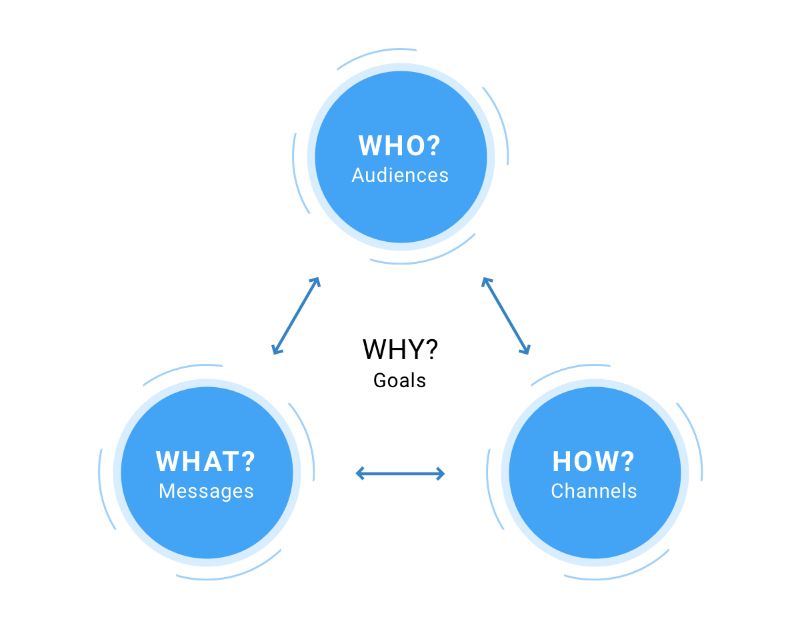
Een communicatiestrategie is een gids die een bedrijf helpt om een merk te worden. Het is een soort lichtbundel die je de weg en de benadering van je publiek laat zien. Het helpt u te leren hoe u mensen extra waarde kunt bieden in de vorm van inhoud van hoge kwaliteit en hoe u met hen kunt communiceren op een manier waardoor ze van uw product houden. (Of niet haten, ha!)
I know, it does sound a bit complicated, so why can’t we just play it by ear? Why do we need a strategy? The general answer is that if you want to run a successful business, you need to plan your course in advance. Sure, you need to be flexible and ready to change, if necessary, but to work efficiently, you have to set your goals and define the purpose of what you’re doing.
Any strategy is a canvas for decision-making. A communication strategy will help you define your audience(s) and consistently articulate your message, so that both staff and stakeholders can be on the same page about what your product is all about. This unification will also lead to smarter decisions and save a lot of time and money. If you understand your audience, you will direct your efforts more precisely, and with the alignment of staff, board and other stakeholders, it will be easier to get your message across.
One more reason – and an oh-so important one – to get yourself a solid communication strategy is to measure success. When putting together your strategy, include benchmarks and an evaluation process. Later on, you can see whether your business achieved the goals you set, or if you need to make a mid-course correction. Be prepared to experiment!
Developing a Communication Strategy, Step by Step
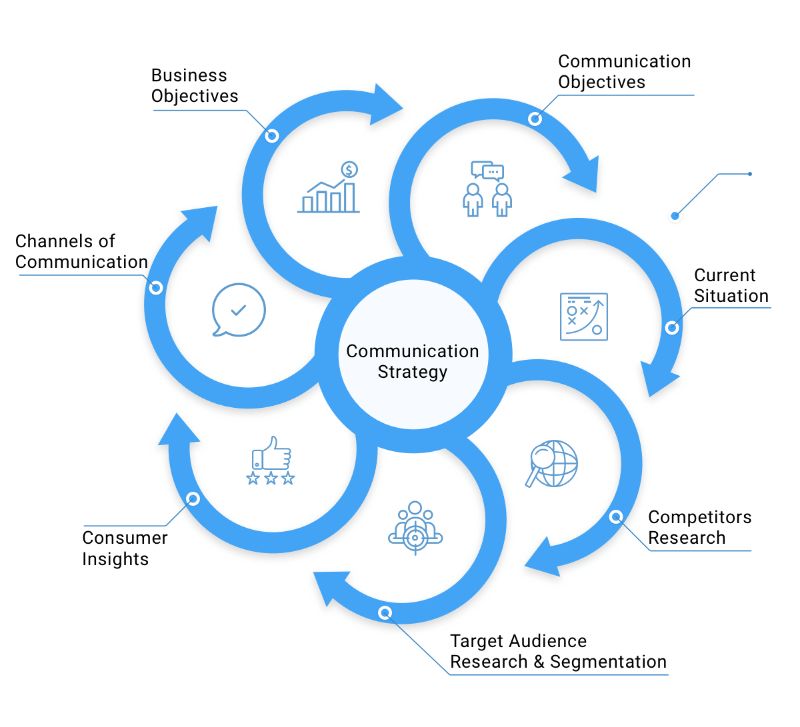
If it’s the first time you’re developing a communication strategy for a business, you should get some sort of communication strategy to-do list to make sure you don’t forget anything. Here’s a little cheat sheet on what’s important:
Define Your Business Objectives
First of all, start with assessing your business’ current situation. After you’ve established where you’re at, think about the short- and long-term goals for your business. Why did you start this business in the first place? What are you trying to achieve? What needs are you fulfilling? Usually, business objectives include:
- profitability (making sure that revenue is always ahead of the costs of doing business)
- productivity (maintaining equipment, training staff, etc.)
- good customer service
- employee retention
- protection of core values
- growth and change management
- marketing.
For example, you own a company that helps sell music, both digital and physical, via the web and an app. You offer an exquisite selection of music that sells well. You make sure your app functions properly, and that all technology, including payments and music streaming, is up to date and functions properly. You can afford to pay your employees a decent wage, which leads to good employee retention. You help your employees learn by signing them up for workshops, seminars, and other professional events in IT, music promotion, monetizing music from streaming services, etc. You build a good team that grows.
Define Your Communication Objectives
From the business objectives, we step over to the communication objectives.For a business to be successful, they both have to align, because if you don’t know where you stand in the market and where you’re supposed to go, it’s too early to set communication objectives. For instance, if you don’t define your pricing policy, there’s no sense in defining a target audience that will be able to buy your product for a certain price.
Decide what your startup wishes to achieve in the communication sector. For example, in the beginning you want to inform potential customers, partners or collaborators about your company, raise brand awareness and brand recognition, create demand for your product, and build loyalty. This will help you make your business profitable and help it grow.
Apart from achieving business/organizational objectives, communication objectives can also include:
- Сreating brand awareness
- Building loyalty (both within target audience and employees)
- Stimulating a want or desire
- Imparting knowledge
- And many more…
And always remember: it’s important not only to set goals, but also to make sure you’re moving towards them.
Analyze Your Current Situation
Any communication strategy should begin with an introduction. This should contain information on your business and outline its activities and products, main focus and functions, and where it’s based.
There are specific tools that will help you analyze your current situation and continue planning your business’s future.
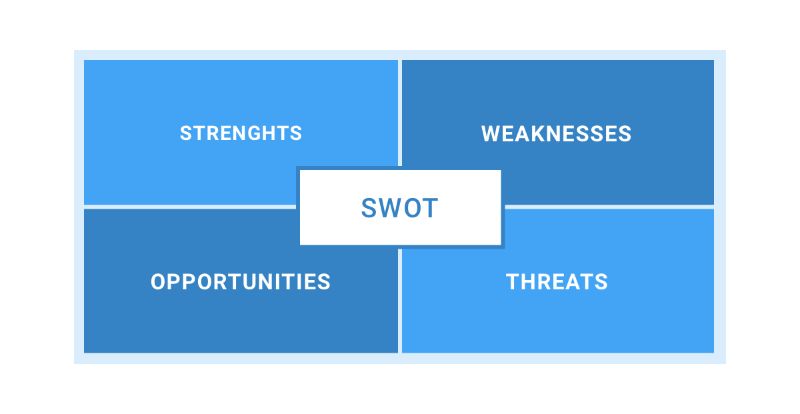
SWOT analysis is all about listing your organisation’s strengths, weaknesses, opportunities, and threats. Think about what these mean for your business if there are any weaknesses, how can they be turned into opportunities, and how threats can be avoided or eliminated.
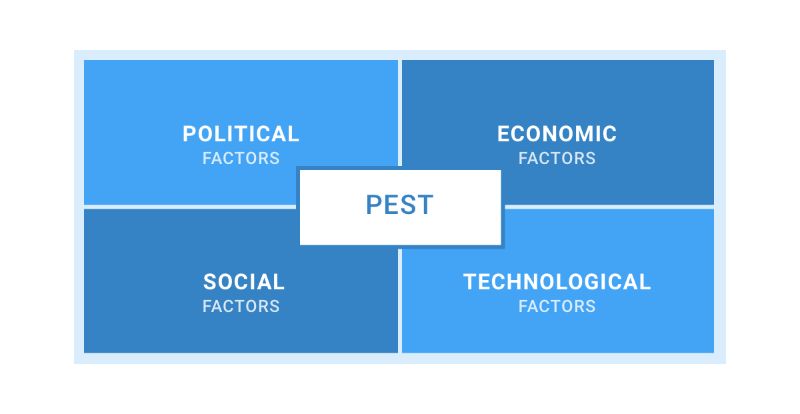
PEST analysis is a tool that takes into account Political, Economic, Social and Technological factors that may affect the work of your company. These can be either positive and negative, and you should list the reasons why they will have an effect on your startup’s operation. PEST analysis should help explore new thinking, not just conform with what you have at the moment.
Sometimes, you may see other abbreviations – PESTEL (the E and the L stand for Environmental and Legal) or STEEPLE (with the addition of Ethical) or STEEP (including Economic and Environmental instead of Legal), but basically it’s all about the same processes.
Research Your Competitors
Whenever you start a new venture, you will obviously check out what your competitors in this field are doing. It’s good to see what’s in the market you’re entering – so on one hand, you know your options, but on the other, you don’t repeat what has already been done. The idea is to create something unique that will fill an empty niche.
The same goes for communication strategies. You need to see how your competitors behave in terms of building communication to understand the market better, and to create your own unique positioning.
Also, go to your competitors’ websites, examine the customer experiences they offer, check out their pricing, shipping, etc. Knowing all this will help you get an edge over your competition.
First of all, you will see where your competition directs their communication. Then you will see how they do it, and monitor their behavior. Using this knowledge, you’ll be able to anticipate their moves, which will help you always stay one step ahead.
Conduct Target Audience (TA) Research and TA segmentation
Having explored the field and what your competitors are up to, it’s now time to learn about your target audience. You don’t want to spend your precious limited startup resources on an overly broad audience that doesn’t want, need, can afford or appreciate the product you invested so much time and money in.
If you’re at a loss and can’t describe your future customers on the spot, go back to the time when you planned your business. You must have thought about who your product or service is going to appeal to, or who you want it to appeal to the most. This is the answer that reveals who your target audience is, the people to whom you’re going to direct your communication and advertising. Here’s a more detailed breakdown:
- Make a list of populations or individuals you want to sell your product to. The list can be pretty long and cover a wide population range. For the music app, it can be as wide as “male and female adults 18-99 yo with access to high-speed Internet".
- Rank your audience to see who in it is the most important target at the moment. Although music is a common interest among all age groups, younger people tend to be more acquainted with technology and prefer apps and streaming over CDs, for example. Accordingly, you will want to communicate your digital services to them first.
- Do audience segmentation to make your advertising even more targeted. This means breaking down your audience according to certain criteria, or on the needs of a certain group, so you can deliver your ads at the right time and in the right place.
For example, you can promote different releases depending on the geography of their popularity or relevance, like Independence Day playlists or Christmas discounts.

It used to be quite simple. The demographic-based principle used to be the the largest picture of a consumer: is the person male or female? How old are they? Where are they based? etc.
These days, these metrics don’t help you that much – people use different smartphones, laptops, tablets, wearable fitness bands, etc. not to mention countless apps, browsers, emails and more.
Consumer behavior and working patterns change, and lifestyles and people’s values evolve and transform – which is why the next logical step in the evolvement of this principle is creating user personas.
Define Consumer Insights
To get a hold of all of these characteristics and be able to use them for your communication and marketing strategies, you’ll have to conduct consumer insight research. As soon as you get inside the head of your customers, you will find out why they made this purchase, why online and not from a store, why on a weekday and not or a weekend, etc., and make a prognosis about their behavior in the future.
All this is actually what customer development is based on – it’s the perfect way to develop a product specifically for your audience. Steve Blank, the founder of the customer development approach, says, “There are no facts inside the building, so get the hell outside." Which means you have to go out there and get your data.
But keep in mind that there’s no single tool to help you get consumer insights – you can’t get them from a focus group or a survey. You need to go through a combination of activities to gather relevant information, and analyze what you get.
Determine Channels of Communication
At this point, you already know your target audience and the basics of its behavior. Now, make a list of media outlets and channels that can help you reach them. Think carefully: where does your message have the best chance of catching their attention? Before creating the messages and the content, you need to know the format of your communication with your customers. You need to find out what communication channels your target audience already uses.
For example, if you’re creating a persona, what social media does he or she use? Where does he or she read their news? Does this persona read newsletters? A proper UX research will help you understand not only where, but also how, which is no less important.
By the way, if you’re defining communication channels for your audience, don’t forget an option called omni-channel communication. Right now, it’s considered to be one of the most progressive ones.
And, considering the effects of different channels on the recipient, plan a timeline and key dates to know to whom and when you are going to communicate.
Define Positioning and Key Messages for Different Target Audiences and Channels
A company’s positioning and core messages help people understand why a company is useful, what values it has, what it believes in, and how it stands apart from its competitors. It’s like you’re meeting a new person and need to decide whether you like them or not, based on what this person does and their views on life.
Messaging can come in the form of a tagline, ad slogan, headline, or a sales pitch. Whatever it is, the message has to be consistent across all of the brand’s marketing channel, whatever segment of your TA you’re addressing, and suit the channel. Just remember to keep the message relevant and appropriate to the group you’re speaking to.
To get your message across successfully, try to follow this formula:
Identify audience segment -> Identify key message -> Identify reason to believe -> Identify the most appropriate channel

Communication Strategy: The Template
This is probably a lot to take in at once – but trust me, this is all very important to planning your business and your future. So let’s try to put all we’ve learned into a graphic.
- Overall Business Objectives
Establish where you are and where you want to go.
- Communication Objectives
Define your communication goals and how they align with your business objectives.
- Current Situation
Analyze inner factors that can affect your business, like your company’s strengths and weaknesses and external factors like politics, the economy, etc.
- Research your competitors
Know your competition to get an edge over them.
- Target Audience
Establish who your target audience is to know what communication style to choose and how to sell them your product or service. Use customer insights.
- Communication Channels
Go through the list of your target audiences and think of the most appropriate communication channels to use to reach each audience. Make a timeline according to your planned key activities in the near future.
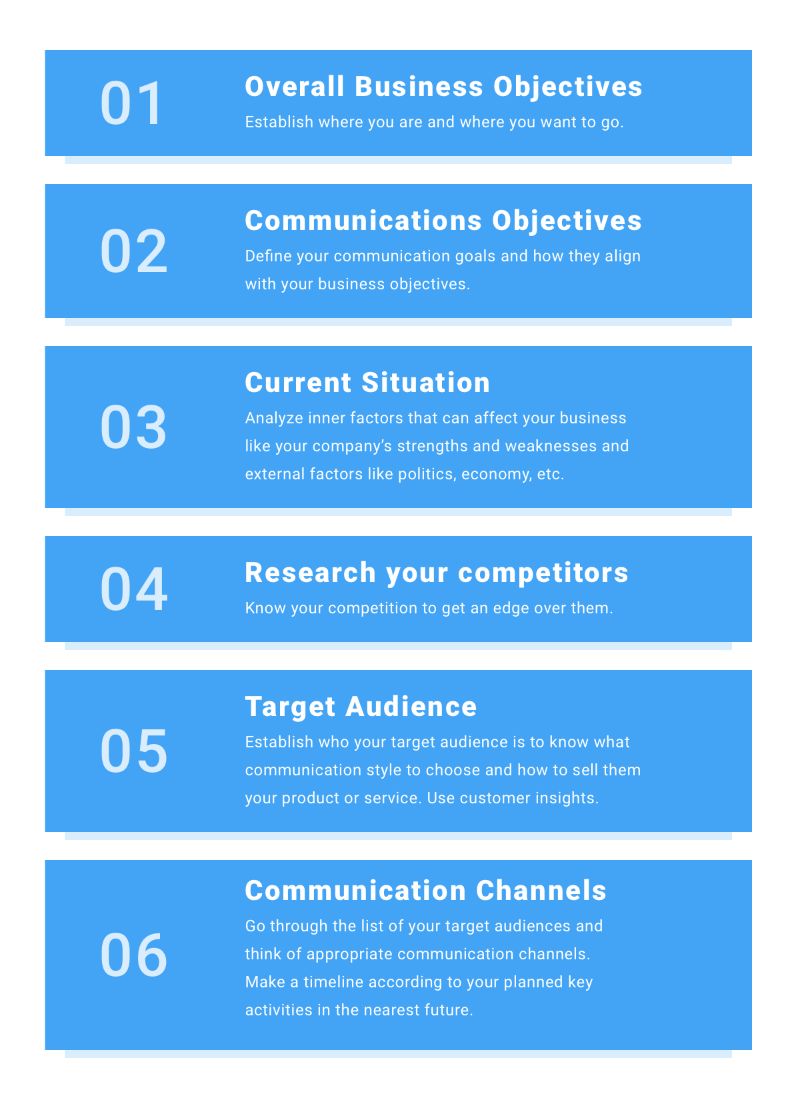
What’s Next?
Part of your communication strategy is the content strategy. This is all about the management of any media you produce or own, be it written, visual, or downloadable.
You decide who you’re creating it for, and what problem it’s going to solve for the audience. Then you can brainstorm content ideas. Keep in mind that your content is what shows your values to the entire world, and, among other things, gives your audience additional value. Apart from that, you decide how your content going to be unique, what format it’s best transmitted in, and through what channels. After you’ve done all of this, you schedule and manage the content creation and publication.
The communication strategy was all about how to reach your audience, how to grab their attention, how to create decent content, not just content for the sake of it. The content strategy is part of a bigger tool set that helps you do this.
Right now it may be hard to believe, but everything I’ve described here is critical to understanding where your business is and how to communicate with your audience. It will help you understand your business and your future better.
As we said earlier, communication is the bond between all of us. It is what helps us through good days and bad days. Communication between people and brands has its ups and downs, just like communication between people. And if a person doesn’t like what you’re saying, it may be hard to convince them that your product or service is worth their attention. But if you start a respectful and caring communication process, you’ll be guaranteed some loyal customers and a better chance of success.
Het meest interessante aan deze vrouw is dat zij mij is. Ik besloot om niet te liegen - je kunt een paar stukjes van mijn geest en hart overal in Product Tribe zien. Dat is eigenlijk wie ik ben. Ik ben woorden, ideeën, snelle beslissingen, veel luchthavens, bussen, veerboten en zelfs nog meer verhalen (waarvan de meesten mijn moeder nooit zullen horen). Ik geloof dat mijn passie voor het verkennen van de wereld en mijn bereidheid om verschillende levenservaringen te accepteren mij een betere schrijver, marketeer en persoon maken.

Source: producttribe.com

